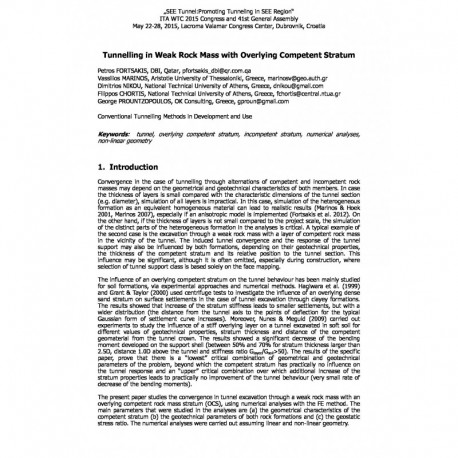Cart
0
0
No document
0,00 €
Total
Document successfully added to your shopping cart
Quantity
Total
There are 0 items in your cart.
There is 1 item in your cart.
Total documents
Total shipping
To be determined
Total
Search & filter
Search for a publication
Search & filter
Viewed documents

Tunnelling in Weak Rock Mass with Overlying Competent Stratum
wtc2015_full_fortsakis
G. Prountzopoulos / F. Chortis / P. Fortsakis / V. Marinos / D. Nikou
Convergence in the case of tunnelling through alternations of competent and incompetent rock masses may depend on the geometrical and geotechnical characteristics of both members. In case the thickness of layers is small compared with the characteristic dimensions of the tunnel section (e.g. diameter), simulation of all layers is impractical. In this case, simulation of the heterogeneous formation as an equivalent homogeneous material can lead to realistic results (Marinos & Hoek 2001, Marinos 2007), especially if an anisotropic model is implemented (Fortsakis et al. 2012). On the other hand, if the thickness of layers is not small compared to the project scale, the simulation of the distinct parts of the heterogeneous formation in the analyses is critical. A typical example of the second case is the excavation through a weak rock mass with a layer of competent rock mass in the vicinity of the tunnel. The induced tunnel convergence and the response of the tunnel support may also be influenced by both formations, depending on their geotechnical properties, the thickness of the competent stratum and its relative position to the tunnel section. This influence may be significant, although it is often omitted, especially during construction, where selection of tunnel support class is based solely on the face mapping. The influence of an overlying competent stratum on the tunnel behaviour has been mainly studied for soil formations, via experimental approaches and numerical methods. Hagiwara et al. (1999) and Grant & Taylor (2000) used centrifuge tests to investigate the influence of an overlying dense sand stratum on surface settlements in the case of tunnel excavation through clayey formations. The results showed that increase of the stratum stiffness leads to smaller settlements, but with a wider distribution (the distance from the tunnel axis to the points of deflection for the typical Gaussian form of settlement curve increases). Moreover, Nunes & Meguid (2009) carried out experiments to study the influence of a stiff overlying layer on a tunnel excavated in soft soil for different values of geotechnical properties, stratum thickness and distance of the competent geomaterial from the tunnel crown. The results showed a significant decrease of the bending moment developed on the support shell (between 50% and 70% for stratum thickness larger than 2.5D, distance 1.0D above the tunnel and stiffness ratio G/G>50). The results of the specific paper, prove that there is a “lowest” critical combination of geometrical and geotechnical parameters of the problem, beyond which the competent stratum has practically no influence on the tunnel response and an “upper” critical combination over which additional increase of the stratum properties leads to practically no improvement of the tunnel behaviour (very small rate of decrease of the bending moments). The present paper studies the convergence in tunnel excavation through a weak rock mass with an overlying competent rock mass stratum (OCS), using numerical analyses with the FE method. The main parameters that were studied in the analyses are (a) the geometrical characteristics of the competent stratum (b) the geotechnical parameters of both rock formations and (c) the geostatic stress ratio. The numerical analyses were carried out assuming linear and non-linear geometry.


